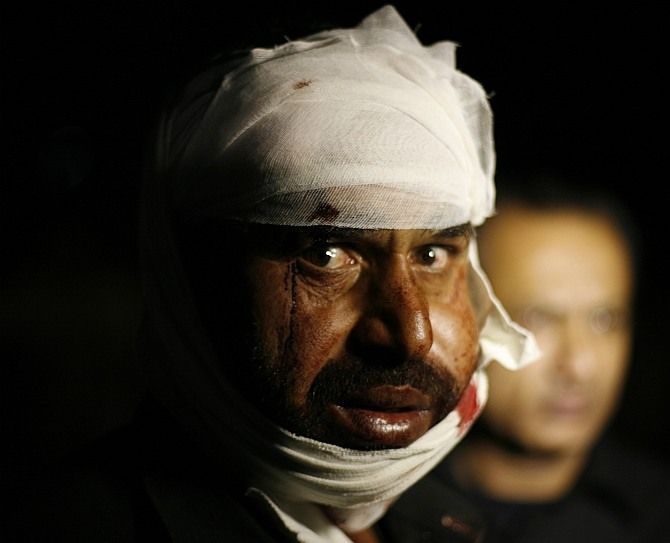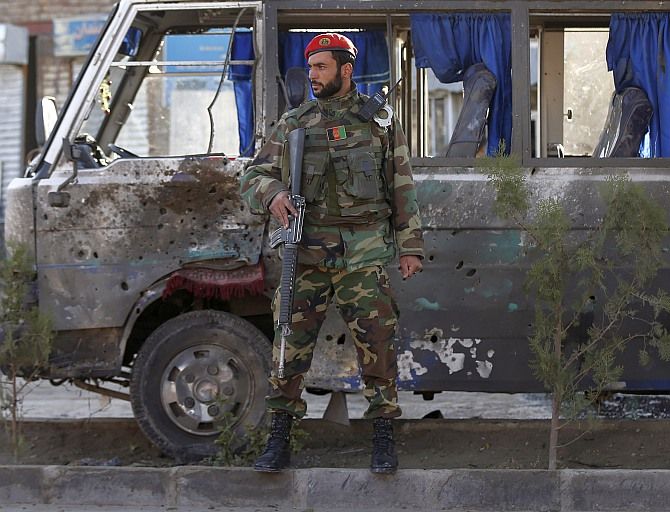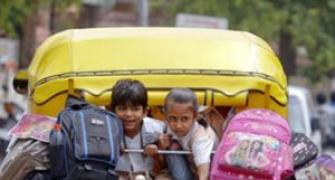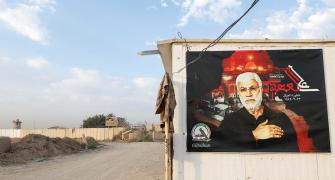The Global Terrorism Index 2014, prepared by the Institute for Economics and Peace, is out.
The 2014 report states that there were nearly 10,000 terrorist attacks in 2013, 44 per cent more than the year before.
The report, which investigates terrorism trends between 2000 and 2013, uses data from the US-based Global Terrorism Database.
While Iraq and Afghanistan top the list as the most terror-affected nations, India has been ranked number six.
Let's take a look at the 10 most terror-affected nations:
India - Rank # 6
Score: 7.86 / 10
Number of Deaths: 404
The Report Says: Terrorism increased by 70 per cent in India from 2012 to 2013. However, the majority of terrorist attacks in India have low casualties. In 2013 around 70 per cent of attacks were non-lethal. There were attacks by 43 diferent terrorist groups who can be categorised into three groups: Islamists; separatists; and communists.
Communist terrorist groups are by far the most frequent perpetrators and the main cause of deaths in India. Three Maoist communist groups claimed responsibility for 192 deaths in 2013, which was nearly half of all deaths from terrorism in India. Police are overwhelmingly the biggest targets of Maoists, accounting for half of all deaths and injuries.
India’s north east region has for the last three decades seen continual ethno-political unrest from ethnic secessionist
movements. Separatist groups including in Assam, Bodoland, Kamtapur and Meghalaya were responsible for 16 per cent of
deaths.
The majority of attacks occur in Hyderabad in the south, a city with a 40 per cent Muslim population, and Jammu and Kashmir in the north, an area which is nearly two thirds Muslim.
Iraq - Rank # 1
Score: 10 / 10
Number of Deaths: 6,362
The Report Says: Iraq continues to be the country that is most impacted by terrorism. 77 per cent of attacks for which a group claimed responsibility were conducted by ISIL. The oldest group, Ansar al-Islam, was formed in 2001 but has subsequently joined ISIL.
Some of the groups are relatively new such as Mukhtar Army, a Shia Iraqi militia group formed in early 2013, and Al-Nusrah
Front, a branch of Al Qaeda formed in 2012.
The majority of terrorist groups in Iraq are Sunni and are opposed to the Shia dominated government. The tactics used by terrorist groups in Iraq remain almost exclusively confined to bombings and explosions. This method was responsible for 87 per cent of deaths and 97 per cent of injuries. Suicide attacks also continue to be used with a very high cost on human lives, with an average of over seven deaths per suicide attack.
There were 232 suicide attacks, which were responsible for 27 per cent of fatalities. ISIL took responsibility for the majority of suicide bombings, averaging nearly 10 deaths and 18 injuries per attack.
Afghanistan - Rank # 2
Score: 9.39 / 10
Number of Deaths: 3,111
The Report Says: Whilst there were seven diferent terrorist groups active in Afghanistan, one group, the Taliban, was responsible for the majority of attacks and casualties. The Taliban remains one of the most deadly terrorist groups in the world.
In 2013 there were terrorist acts in over 440 diferent cities in Afghanistan, clearly highlighting the breadth of terrorism
across the country.
Bombings and explosions were the most common tactic used in Afghanistan, accounting for over half of all attacks and fatalities.
Pakistan - Rank # 3
Score: 9.37 / 10
Number of Deaths: 2,345
The Report Says: Terrorism in Pakistan is strongly influenced by its proximity to Afghanistan with most attacks occurring near the border involving the Taliban. In 2013 there were 23 diferent terrorist groups, down from 29 groups in 2012. However, 11 groups account for the majority of the 270 claimed attacks. While many of these groups are Islamist there are also other organisations such as separatist movements for Baloch, the Bettani tribe and Sindhi people
The deadliest attacks were against religious figures and institutions which, on average, killed over five people and injured over 11 per attack.
More than 500 cities in Pakistan had at least one terrorist incident in 2013, with two or more incidents occurring in 180 cities. Of all attacks 16 per cent occurred in the largest city of Karachi in the south. However, the majority of attacks occurred in the north closer to the border with Afghanistan. This includes cities such as Peshawar, Quetta and Jamrud, which combined, had more attacks than Karachi.
Nigeria - Rank # 4
Score: 8.58 / 10
Number of Deaths: 1,587
The Report Says: The dramatic increase in terrorism in Nigeria can be attributed to the rise of Boko Haram. Boko Haram can be translated to mean ‘western education is forbidden’. They are one of the most deadly terrorist groups in the world with an average of close to eight deaths per terrorist attack.
The nature of terrorism in Nigeria is diferent to Iraq, Afghanistan and Pakistan. Terrorist activity in Nigeria has more in common with the tactics of organised crime and gangs, focusing on armed assaults using firearms and knives than the bombing or suicide tactics of other large terrorist groups. Armed assault has claimed 85 per cent of deaths in Nigeria while bombings or explosions account for five per cent of deaths. Suicide attacks are very rare, approximately 12 per cent of terrorist attacks are kidnappings or hostage takings.
Syria - Rank # 5
Score: 8.12 / 10
Number of Deaths: 1,000
The Report says: The dramatic rise of terrorism in Syria is a direct result of the civil war. There are at least ten diferent terrorist groups active in Syria, many of which are Sunni and opposed to the Alawite Assad regime.
It is estimated that the civil war has led to between 180,000 and 260,000 deaths and the displacement of over 35 per cent of the population of the country. The majority of these deaths are classified as a result of conventional warfare rather than
acts of terrorism. However, terrorism has been deployed as a tactic by some of the rebel forces to bring about a political,
economic, religious, or social goal rather than purely military objectives.
The Sunni and al-Qa’ida linked Al-Nusra Front claimed responsibility for more than 40 per cent of deaths from terrorism in 2013. This group regularly uses suicide attacks, employing suicide bombing in nearly a third of their attacks. They are also one of the most deadly groups, averaging nearly 19 deaths per attack.
Somalia - Rank # 7
Score: 7.41 / 10
Number of Deaths: 405
The Report Says: 2013 has been the deadliest year of the past 14 years. The Al-Shabaab group was responsible for all claimed
attacks. This militant group is allied with Al Qaeda and has an estimated 4,000 to 6,000 soldiers. Unlike some other Al Qaeida afliates, there has been infighting in Al-Shabaab over whether it should focus on local and regional objectives rather than transcontinental jihad.
Notably, this was one of the reasons why the American recruit to Al-Shabaab, Abu Mansoor Al-Amriki, was killed by Al-Shabaab in 2013 as he criticised the group for being too focused on Somalian outcomes to the detriment of international jihad. Nevertheless, Al-Shabaab has attracted foreign fighters and has partnered with other groups.
Al-Shabaab was responsible for the Westgate shopping mall attack in September 2013 in Kenya, which resulted in 67 deaths and 175 injuries. This was reportedly in retaliation for the involvement of the Kenyan military in a military operation to eradicate the group in Somalia.
Yemen - Rank # 8
Score: 7.31 / 10
Number of Deaths: 291
The Report Says: Terrorist attacks and injuries increased by 50 per cent between 2012 and 2013. Whilst there were nine diferent groups active in Yemen in 2013, two major terrorist groups committed over 80 per cent of terrorist acts. The other groups include tribesmen and separatists.
It is unknown who committed 16 per cent of attacks in 2013. The two most active terrorist groups are the Houthis and Al Qaeda in the Arabian Peninsula. The Houthis are the smaller group and claimed responsibility for 20 per cent of deaths in 2013 with 18 separate attacks, whereas AQAP claimed responsibility for 60 per cent of attacks in 2013 with 83 separate attacks.
Both groups in Yemen are in conflict with the government and deploy terrorist tactics. Despite this, the Houthis and AQAP are opposed to each other and are based in separate parts of the country.
Philippines - Rank # 9
Score: 7.29 / 10
Number of Deaths (2013): 292
The Report Says: Terrorism in the Philippines is intrinsically tied with nationalist and separatist claims by people living in provinces in southern Philippines. However, terrorism is spread across the country. There were 438 cities that sufered a terrorist attack in 2013 of which only 104 had one attack. The city that saw the highest number of terrorist attacks was Cotabato City in Mindanao with 11 separate attacks that killed 11 people. 83 per cent of the 81 provinces of the Philippines had at least one terrorist attack in 2013.
Thailand - Rank # 10
Score: 7.19 / 10
Number of Deaths (2013): 131
The Report Says: Terrorist activity is overwhelmingly confined to the south of the country where there is an ongoing insurgency between Muslim separatists and the Thai government, with Malay Muslims opposed to the Thai Buddhist minority and supporters of the government. This conflict has been ongoing since 2004 with estimates of 5,000 deaths and 10,000 casualties.
The number of bombings increased 50 per cent between 2012 and 2013, with 170 separate bomb attacks. However, the majority of bomb attacks resulted in no fatalities with 44 total deaths as opposed to 77 deaths by firearms. The biggest targets were businesses followed by police. The majority of terrorist attacks in Thailand have relatively low death rates, with an average of 1.2 deaths per attack. No attack killed more than six people in 2013.










